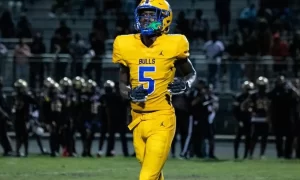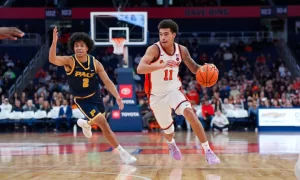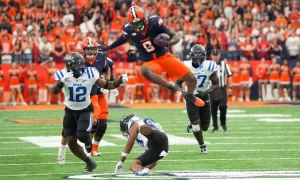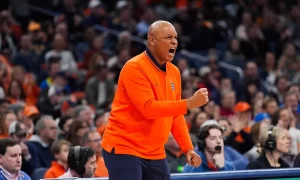Jim Boeheim flew to Minnesota last weekend to watch class of 2013 point guard Tyler Ennis open his season in the Nike Elite Youth Basketball League. If it had taken place a year ago, the trip would have been a recruiting violation.
An NCAA rule change has given coaches the opportunity to see prospects in person at AAU and travel-team events during the final two weekends of April. In the past, coaches were barred from attending such events from the end of March until early July.
Ennis is a consensus top 10 point guard in his class from Brampton, Ontario and attended SU’s Midnight Madness this fall. He spent the day with the team and told The Fizz,¬†‚ÄúIt just shows how college is and how serious that you practice, and how much of a family it is.‚Äù
He talked to us about what he specifically likes about SU. “It’s close to home. I like how they have a family atmosphere. Even when you graduate, you’re still a part of the Syracuse family.”
At the time we wrote: “He‚Äôs a pass-first player and a steadying influence on offense. None of the major recruiting services even list Syracuse as a possibility for Ennis, so it was a surprise that he attended Midnight Madness.”
CBS Sports blogger Jeff Borzello did a tremendous job of explaining why the rule change that allowed Boeheim to watch Ennis matters.
‚ÄúAllowing college coaches back on the road for two weekends in April is a positive change for the recruiting calendar. With the number of recruits making early decisions nowadays, it was necessary that coaches gave prospects a true evaluation outside of the school season. There were too many scholarship offers being handed out during the spring AAU season – when coaches weren’t able to watch players.‚Äù
If a prospect wanted to commit early, coaches had to trust scouting services and other sources in order to assess that recruit. And that didn’t serve anyone well.
‚ÄúIf a school accepts a commitment from a player without seeing them in person, it could lead to problems. It’s one of the many reasons the transfer list is well over 300 players long and still growing, and also one of the reasons there are more de-commitments and pulled scholarships late in the recruiting process.
For example, a coach may have offered a scholarship in April without watching a prospect in person. After seeing him play a few months later, that coach may not like what he sees. Then you’re caught in an awkward relationship. Sometimes that leads to “parting ways” after freshman year?‚Äù
Boeheim recently spoke with Colin Cowherd on ESPN Radio about how transfers can hurt a program.
“I’m told there’s 90 guys transferring this year. And one of the things with the new academic thing (APR) is coaches really need to hold kids because when a kid transfers, you lose an academic point. That can hurt and affect your program going to the tournament, hurt the players in your program, when you start losing academic points.”
Good recruiting is as much about finding the right people as it is landing the best talent. Both the school and the athlete should completely understand what they are getting into before a letter of intent is signed, which this rule change helps ensure.
It took no time for the adjustment to help Syracuse, judging by the words of Ennis, an excellent passing and ball-handling PG, who could be a cornerstone player for the Orange.
“It feels good to have a Hall of Fame coach coming out to your games to watch you and show interest in you.”
An extra chance to take a visit gave Boeheim another opportunity to develop a relationship with a consensus top-10 point guard in the 2013 class.
Posted: Andrew Kanell






















